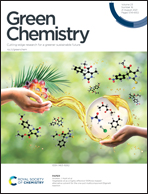Direct transformation of industrial vegetable waste into bioplastic composites intended for agricultural mulch films†
Abstract
The development of mulch films from wastes of vegetables represents a sustainable alternative to the traditionally used polyethylene ones that follow the principles of circular economy. In this work, we obtained films based on two different industrial vegetable wastes, orange peels (OP) and spinach stems (SS), using hydrolysis at different times (6, 16, and 24 h) and temperatures (30, 50, and 70 °C). Hydrolysis carried out at 30 °C and 24 h has led to films with the best mechanical properties, while high temperatures (70 °C) combined with prolonged treatment times (16 and 24 h) led to materials with lower mechanical resistance and darker coloration. The films’ characterization by X-ray diffraction (XRD), Fourier Transform infrared spectroscopy (FTIR), nuclear magnetic resonance (NMR), thermogravimetric analysis (TGA), and uniaxial tensile tests elucidated their chemical structure and physicochemical properties. Additionally, the materials’ interaction with water was evaluated and significantly improved by adding a carnauba wax coating. Optical properties, micro and macronutrient content and biodegradation in the soil of selected bioplastics were also determined. Results showed that the proposed materials present fast in-soil biodegradation, good potentiality for weed prevention and improvement of plant growth via soil fertilization.



 Please wait while we load your content...
Please wait while we load your content...